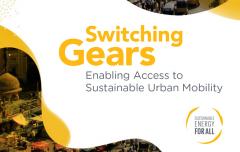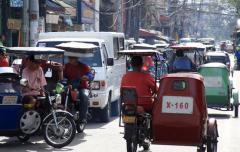Sustainable and decarbonized mobility for all: The time to act is now
Cities account for 70 percent of worldwide GHG emissions and 50 percent of the world’s population, but only 3 percent of Earth’s land area. Fossil-fuel based transport is contributing to these high emissions and the ongoing climate crisis. The poor air quality observed in approximately 90 percent of cities worldwide is also exacerbated by fossil-fuel based transportation, outdated buses, inefficient cars and trucks.
By 2050, both urban transport energy consumption and emissions are expected to double if nothing changes. At the same time, millions of people still lack access to energy or mobility services. Leveraging the nexus between energy and mobility is necessary to provide these services, especially to the urban poor and to the most vulnerable populations.
Several Sustainable Development Goals (SDGs) and the Paris Agreement emissions targets hinge on rapid evolution of the transport sector and how it is powered. We need to explore the opportunities for securing sustainable urban mobility for all in lock-step with decarbonizing the transport sector.
Sustainable transport for all in fast-growing cities
Providing mobility services to more people is a question of equity, but if done unsustainably, not only will the SDGs not be met, but more cities will become choked in air pollution and gridlock. Yesterday was the time to act for many mega-cities. Major metropolises now find themselves in a situation where they must dig themselves out of problems rather than plan proactively. For fast-growing cities of 300,000 to 1,000,000 inhabitants, there is a chance to do something impactful right now.
Energy and mobility access need to expand in parallel with population growth and urbanization. Predictable and manageable urban growth can be achieved through conscious planning of energy and mobility systems. Fast-growing cities are better positioned for this type of planning and execution—they have the chance to leapfrog technologically and developmentally. A large share of future urban growth is projected for these small-to-medium-sized cities in developing countries in Africa, Asia and Latin America.
Linking the energy and transport sectors
Both the energy and transport sectors need to consider efficiency and sustainability from start to finish, move out of siloes and into synergies.
Energy and mobility can be linked in a meaningful way in order to achieve more SDGs than if implemented separately. Sustainable energy access and low-carbon mobility should be developed together to deliver new sustainable services for those previously underserved. For the urban poor, access to any type of energy or mobility services, let alone sustainable ones, is currently often out of reach.
Energy and mobility are derived demands and need to be linked to enable effective services by ensuring three things:
- Energy supply for mobility is as clean as possible, which will be more effective by including the energy sector from the outset for electric mobility
- Integrating not just land-use and urban planning, but also the energy sector and energy efficiency, reaping multiple benefits of a systems approach
- By using demand-side management mapping of both mobility and energy, there is a higher chance to provide both, while discouraging unnecessary travel
There are challenges, but there are real opportunities for fast-growing secondary cities. These cities should act now, because only then there is hope for achieving the SDGs globally.
These opportunities are further highlighted in the upcoming report Switching Gears: Enabling Access to Sustainable Urban Mobility, which assesses the status of the energy-transport nexus and how to scale sustainable urban mobility access as rapidly as possible. The report identifies 19 countries around the world –13 in Sub-Saharan Africa as well as Bolivia, Honduras, India, Indonesia, Nepal and the Philippines – and 260 fast-growing small-to-medium-sized cities where the highest impact on the SDGs can be anticipated.
Register here to join our webinar on 19 February.
Photo: Asian Development Bank






